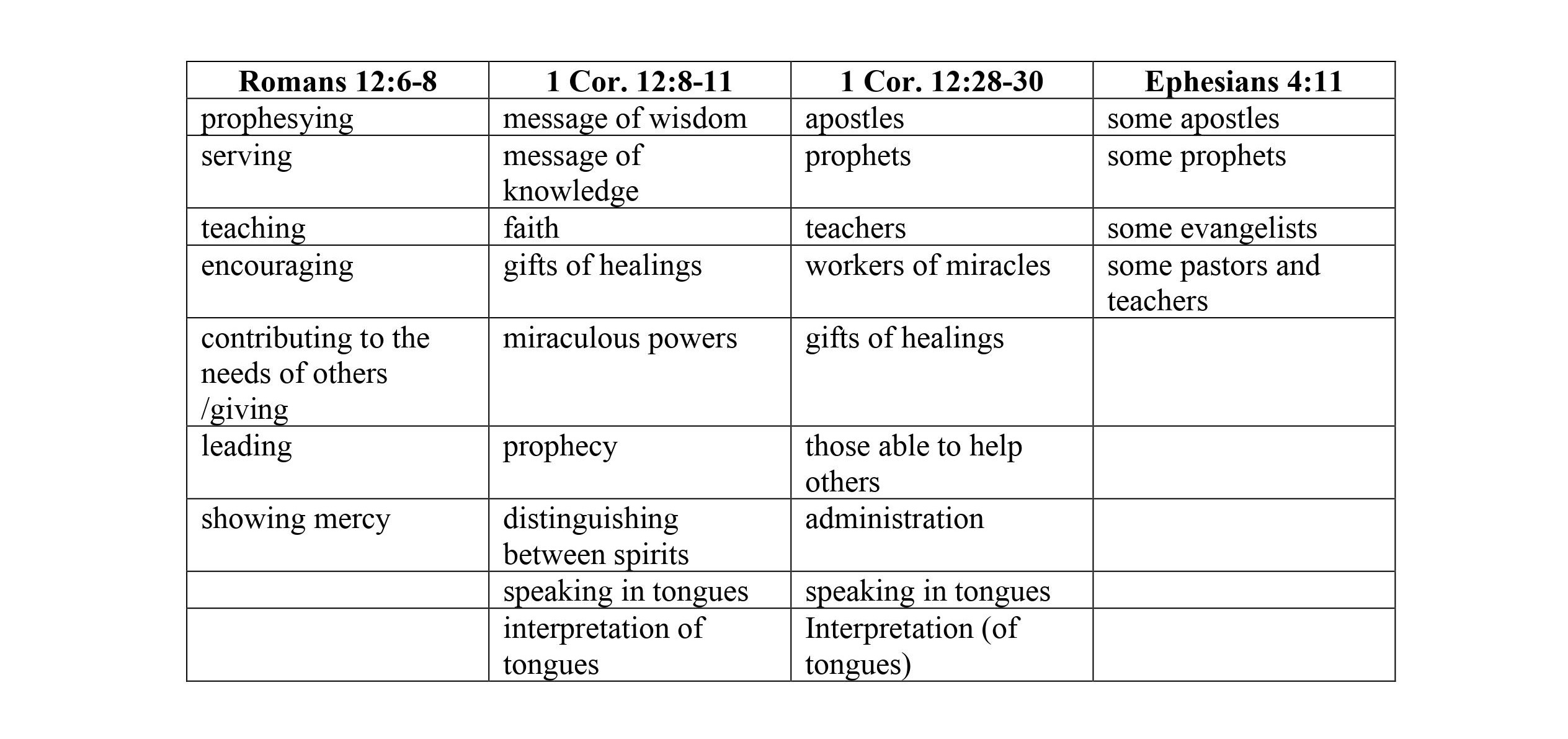
Have you ever been in someone’s tool shed or at a well-equipped workbench? There are tools of every shape and size for every imaginable purpose.
Some of these tools might be used every day, while others only rarely. Their use depends on the construction or repair project of the moment.
In a way, spiritual gifts are like God’s tools; different ways in which He works through His people for the grace-filled benefit of others.
We have learned that these gifts are called charismata because they are bestowals of God’s grace. They are also called pneumatika or spirituals since they are manifestations of the Holy Spirit.
Let’s see what these manifestations of the Spirit, these bestowals of God’s grace, look like.
Lists of ‘gifts’
The New Testament provides us with four detailed lists of spiritual gifts, as well as a general description.
The general description is 1 Peter 4:10-11 in which Peter identifies verbal expressions and non-verbal expressions of God’s grace. We explore those verses in “7 Characteristics of Spiritual Gifts.”
The more detailed lists are Romans 12:3-8; 1 Corinthians 12:7-11; 27-30; Ephesians 4:7-13.
Here is a chart that lays out the gifts mentioned in each of these four texts:

This chart simply lists the gifts or manifestations as they appear in each of the texts, nothing more. For instance, I have not attempted to correlate or equate the various gifts.
Now let’s make some general observations and comparisons among these lists. At this point, it is a good idea to read each of the larger texts within which these lists appear: Romans 12:3-8; 1 Corinthians 12:7-11; 27-31; and Ephesians 4:7-13.
Some observations
1. Selective: It might seem obvious, but none of the lists are identical. They are not even ordered the same. For instance, “prophesying,” “prophecy,” and “prophets” are found first, sixth, second, and second in the four respective lists.
Although there are some overlaps among the lists, the lists are quite varied. Numerous gifts listed for the Corinthians are not mentioned in either Romans or Ephesians.
Here are two basic observations we can make:
- These variations suggest that we have no exhaustive list of all the gifts. There might be others.
- We might also speculate that the gifts mentioned for a particular church are relevant to conditions in that church at that time. For example, in the case of the Corinthians, it appears that they were abusing some of the gifts and needed correction.
2. Trinitarian: Each context appears to focus on a different person of the Trinity. In relationship to spiritual gifts, Romans stresses God (the Father), Ephesians the Son, Jesus Christ, and 1 Corinthians the Holy Spirit.
Keep in mind that Paul typically uses ‘God’ to refer to the Father (e.g., Romans 15:30; 2 Corinthians 1:2; Galatians 1:1; etc.), and ‘Lord’ to refer to the Son, Jesus Christ (1 Corinthians 1:3; 8:6; 2 Corinthians 13:14; etc.). At other times, a careful reading indicates that the term “God” is inclusive of Father, Son, and Spirit. These distinctions in titles do not undermine the deity of the Father, Son, or the Spirit.
3. Activities: I have been stressing that spiritual gifts are activities rather than simply abilities.
The gifts in the Roman list are present participles, action words: prophesying, serving, teaching, leading, and so forth. People are instructed to actively engage with God in living out these gifts.
The gifts in 1 Corinthians are manifestations (or activities) of the Spirit through His people.
The gifts in Ephesians are people: apostles, prophets, evangelists, and pastor-teachers. This might sound a bit awkward, but the people are presented as being the gift—or perhaps better, the embodiment of the gift in action. For example, a prophet is a prophet because that person actively prophesizes.
4. Body: In each of these texts, Paul employs the metaphor of the body to portray the wholesome function of spiritual gifts as diverse in function (e.g., eye, hand, foot) and yet a unity that operates in coordinated harmony. These manifestations of the Spirit are activities within a community of believers. We will come back to this metaphor in another post.
5. Purposes: The purposes of ‘spirituals’ and ‘gifts’ include:
- In Romans, it is an act of worship as we actively live out these gifts in our bodies which have been presented to God as living sacrifices. See “The Dangerous Act of Worship.”
- 1 Corinthians 12:7, it is for the common good. Paul writes, “Now to each one the manifestation of the Spirit is given for the common good.” It is not about self-glorification or self-satisfaction—it is for others.
- Ephesians 4:12-13 expresses gifts “to prepare God’s people for works of service, so that the body of Christ may be built up….”
Summing up
This post has attempted to break out of common portrayals of spiritual gifts and open new horizons for seeing how God the Father, Son, and Holy Spirit manifest their grace to humanity through God’s people, not only for our common good but the benefit of others and the glory of God.
In the next post, we will examine a few of these gifts.
What are your further thoughts and ideas?
You can contact me here.
FORWARD TO Insights into Prophesying, Teaching, and Encouraging
BACK TO Spiritual gifts as a manifestation of the Spirit
Photo credit: Lachlan on VisualHunt.com
Click "yes" to receive resource-rich newsletters.
Helpful resources provided to 'living theology' subscribers.
YES!